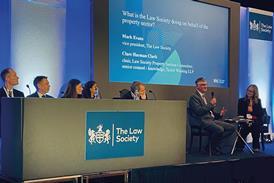In the first of three articles for lawgazette.co.uk tracing the history of ethics and the legal profession, Mark Humphries describes the origins of legal ethics and how medieval regulation addressed the same issues that arise in modern-day practiceThe origins of legal ethicsAn act of professional misconduct is committed by a lawyer who does something which is 'dishonourable to him as a man and dishonourable in his profession' – Re G Mayor Cooke [1889] 5 TLR 407.
If the ethical principles to which a lawyer should adhere were capable of being encapsulated in this single notion, there would be little more to say about ethics and this article would not perhaps have needed writing. Certain basic standards of professional behaviour do exist. These has been regarded as sacrosanct for so long that they may be as relevant in the 21st century as they were when they were first identified in medieval times. When the legal profession first emerged during the reign of Edward I in the late 13th century it may perhaps have been clear enough to say merely that a lawyer must behave with 'honour'; it may even have been clear enough in the 19th century. But those were times when honourable conduct was, to a greater or lesser degree, perhaps easier to identify than is the case when dealing with the complexities of the practice of law today. Such are the intricacies of the modern world that it can no longer simply be said that, if it seems right, it probably is right, but if it feels wrong, it is probably unethical – although for a modern example of this simple approach see Vernon v Bosley (No 2) [1999] QB 18, 63-4 (CA), per Thorpe LJ.
It is not just changing times which may bring about differing perceptions of what is ethical, but also the environment in which a lawyer practises. Thus a lawyer practising advocacy or litigation in the essentially adversarial English court system may well have different views on ethics from those of colleagues who practise in different environments or different jurisdictions. To understand how principles of ethics develop it is necessary first to examine their historical emergence.
Medieval ethicsThe earliest surviving records of medieval principles of ethical conduct for lawyers concern the advocates and proctors who appeared before the church courts. One very early record is a book written in 1239 by William of Drogheda, an Oxford priest and lawyer, advising the reader how to be a successful advocate. The text reveals something of an ironic disconnect between the ethical standards of these two professions on the important subject of remuneration: the author recommends that advocates should ensure payment in advance – 'Get your money while the patient is ill.'
A number of other records date back to the late 14th and early 15th centuries and, while not comprehensive, contain further examples both of the observance of the ethical standards of the time and, indeed, of their breach.
High ethical standards were imposed by the canon law. Lawyers who practised before the church courts were usually clerics who were literate, conversant in Norman French – the language of the secular courts – and adequately trained in the law. They had to be free from 'infamia'. They were obliged to take an annual oath requiring them to charge only moderate fees, to act without charge for poor litigants and to deal honestly with all matters relating to their clients. They were entitled only to accept cases which they believed were properly brought and they were not to make pleas which they did not believe in their conscience to be right. Further, they were obliged to drop cases even during their prosecution if they subsequently discovered them to be without foundation. They were not to engage in conflicts of interest, or 'ambidexterity', sometimes described as 'playing on both hands'. They were not to suborn witnesses unnecessarily to delay litigation or to make frivolous appeals. Proctors were even required frequently to swear the oath of 'calumny' during the course of the proceedings, vouching that their client was acting in good faith.
In practice, however, these early professional lawyers often charged substantial fees based on the amount of work they were required to do and they regulated entry into their professions to ensure that their practices remained sufficiently busy for their desired fee income to be achieved. There is also evidence of judicial corruption, with lawyers acting as intermediaries between litigants and judges, a practice which seems to have been fairly common until the 17th century.
There is surviving evidence, on the other hand, that the early lawyers occasionally acted for poor litigants without taking any fee at all and that, in general, they did not seek to prolong litigation for their own gain but frequently compromised claims rather than pursuing them in the church courts. There is also surviving evidence which shows that medieval lawyers took seriously their duty to the court not to take on unjust claims and were prepared to drop a 'causa desperate' if the injustice of a case emerged during its prosecution. If a lawyer was uncertain as to the good faith of his client he might refuse to swear the oath of calumny, effectively bringing the claim to an abrupt halt. Part 22 of the modern Civil Procedure Rules, which requires statements of case to be verified by a statement of truth, can be seen in some ways as a 21st century equivalent of the oath of calumny.
Statutory regulationThe earliest example of statutory regulation of the English legal profession, emerging at the same time as the profession itself, is chapter 29 of the Statute of Westminster I (1275), in which 'deceit or collusion' by early lawyers was forbidden in the king’s court. This statute was introduced shortly after an inquest by Edward I had found substantial evidence of, among other things, abusive litigation practices by court and royal officials, lawyers and litigants which were having an adverse impact upon the judicial system.
Chapter 29 of the statute provided that '…if any Serjeant, Pleader or other, do any manner of Deceit or Collusion in any King’s Court or consent in deceit of the Court or beguile the Court or the Party and thereof be attainted, he shall be imprisoned for a year and a day from thenceforth shall not be heard to plead in Court for any Man'. Prohibited behaviour included deception of the court or a party and ranged from extortion, bribery and abuse of power to abusive litigation tactics such as champerty, maintenance and barratry (habitually initiating, maintaining or vexatiously persisting in or inciting litigation) through false statements in pleadings and antagonising judges. Indeed, so wide was the discretion given to judges to regulate the conduct of lawyers that the statute was effectively a general prohibition on misconduct by lawyers (even in some cases extending to professional negligence) and breaches were punishable by imprisonment, fines and/or a prohibition upon further pleading.
The London Ordinance of 1280 reflects a continuation of concern over standards of conduct by lawyers, but also over controlling the number of lawyers in practice. The ordinance regulated the admission of lawyers to practise in the City of London courts such that the serjeants and attorneys probably had a monopoly on the right to practise in these courts. Although no doubt partially motivated by self-interest, these early attempts to restrict competition appear to have been aimed at assuring the competency of lawyers in the public interest.
The ordinance also prohibited lawyers from acting for both parties or acting for a party against a former client in the same matter and ensured that a lawyer could not withdraw from proceedings without the consent of the client. Breach of the ordinance was punishable mainly by temporary or permanent suspension from practice. Very few records have been discovered of cases in which the ordinance was applied, and those that exist relate to such diverse conduct as conflict of interests and professional negligence. The former case was settled and in the latter case the sanction was imprisonment.
A further ordinance, promulgated by Edward I in 1292, appears to have been introduced in response to a perception of extensive misconduct by both lawyers and the judiciary. The ordinance placed the supervision of lawyers practising in the king’s courts under the control of the king’s judges. The same ordinance further regulated the admission of lawyers to practise by reference to minimum standards of competence and was designed to reduce the number of practising lawyers to 'seven times twenty', although ultimately the number of appointments was left to the discretion of the justices and the number of 140 was quickly surpassed. The thinking behind this, as confirmed by Edward I himself following the adoption of the ordinance, appears to have been that too many lawyers would mean excessive litigation and that some lawyers could only survive through 'fraud and malice'. The ordinance of 1292 was also the first time that a requirement was formally set out in statute for lawyers to be able to prove their integrity.
There were further statutes in 1402 and 1455 designed to limit the number of practising attorneys and to ensure that they were properly trained, competent and of good moral character. Again, these interventions were in response to public complaints about excessive litigation resulting from incitement to suit, incompetence and misconduct by lawyers.
A series of bills was presented to parliament during the 16th century intended to reduce the number of lawyers and, with it, the number of frivolous suits. In 1606 parliament passed one such bill entitled 'An Acte to reforme the Multitudes and Misdemeanours of Attorneys and Solicitors at Lawe'. The preamble to the act related that excessive and/or fictitious fees had been demanded by lawyers, 'whereby the subjectes growe to be overmuch burthened, and the practise of the juste and honest sergeant and counsellor at lawe greatly slandered'. The act further provided that if any attorney or solicitor should 'willingly delay his client’s suites to worke his own gaine', or if they were to demand more in fees than had been initially indicated, he would be liable to an action for damages of up to three times that value and could be discharged from practice. It also included provisions relating to avoiding 'the infinite number' of solicitors and attorneys.
It is striking that these medieval examples of regulation of lawyers are concerned with the same issues as arise in modern legal practice today: the extent to which restrictions on the right to practise as a lawyer can be justified in the public interest (see, in particular, the director general of fair trading’s report Competition in professions, March 2001); the maintenance of an acceptable level of competence for lawyers; and the prevention of misconduct. They also seem to support the conclusion that public attitudes to lawyers were to some extent hostile from the very earliest days of the profession.
Mark Humphries has 25 years’ experience of contentious legal practice. Until recently a litigation partner and head of advocacy at Linklaters in London, he is now the director of his own commercial disputes firm Mark Humphries Ltd. He is a past chairman of the Solicitors Association of Higher Court Advocates
Next week: the development of professional conduct principles and the emergence of the solicitors’ profession

























No comments yet